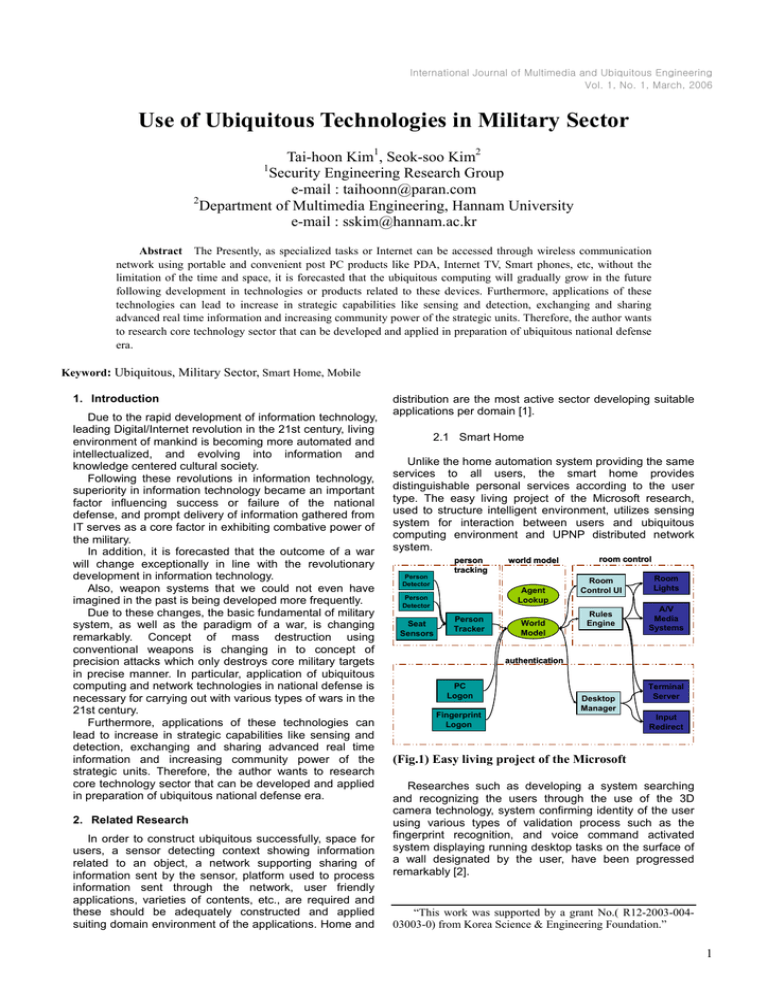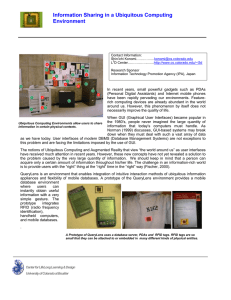Use of Ubiquitous Technologies in Military Sector
advertisement

International Journal of Multimedia and Ubiquitous Engineering Vol. 1, No. 1, March, 2006 Use of Ubiquitous Technologies in Military Sector Tai-hoon Kim1, Seok-soo Kim2 1 Security Engineering Research Group e-mail : taihoonn@paran.com 2 Department of Multimedia Engineering, Hannam University e-mail : sskim@hannam.ac.kr Abstract The Presently, as specialized tasks or Internet can be accessed through wireless communication network using portable and convenient post PC products like PDA, Internet TV, Smart phones, etc, without the limitation of the time and space, it is forecasted that the ubiquitous computing will gradually grow in the future following development in technologies or products related to these devices. Furthermore, applications of these technologies can lead to increase in strategic capabilities like sensing and detection, exchanging and sharing advanced real time information and increasing community power of the strategic units. Therefore, the author wants to research core technology sector that can be developed and applied in preparation of ubiquitous national defense era. Keyword: Ubiquitous, Military Sector, Smart Home, Mobile 1. Introduction Due to the rapid development of information technology, leading Digital/Internet revolution in the 21st century, living environment of mankind is becoming more automated and intellectualized, and evolving into information and knowledge centered cultural society. Following these revolutions in information technology, superiority in information technology became an important factor influencing success or failure of the national defense, and prompt delivery of information gathered from IT serves as a core factor in exhibiting combative power of the military. In addition, it is forecasted that the outcome of a war will change exceptionally in line with the revolutionary development in information technology. Also, weapon systems that we could not even have imagined in the past is being developed more frequently. Due to these changes, the basic fundamental of military system, as well as the paradigm of a war, is changing remarkably. Concept of mass destruction using conventional weapons is changing in to concept of precision attacks which only destroys core military targets in precise manner. In particular, application of ubiquitous computing and network technologies in national defense is necessary for carrying out with various types of wars in the 21st century. Furthermore, applications of these technologies can lead to increase in strategic capabilities like sensing and detection, exchanging and sharing advanced real time information and increasing community power of the strategic units. Therefore, the author wants to research core technology sector that can be developed and applied in preparation of ubiquitous national defense era. 2. Related Research In order to construct ubiquitous successfully, space for users, a sensor detecting context showing information related to an object, a network supporting sharing of information sent by the sensor, platform used to process information sent through the network, user friendly applications, varieties of contents, etc., are required and these should be adequately constructed and applied suiting domain environment of the applications. Home and distribution are the most active sector developing suitable applications per domain [1]. 2.1 Smart Home Unlike the home automation system providing the same services to all users, the smart home provides distinguishable personal services according to the user type. The easy living project of the Microsoft research, used to structure intelligent environment, utilizes sensing system for interaction between users and ubiquitous computing environment and UPNP distributed network system. Person Detector person tracking Agent Lookup Person Detector Seat Sensors world model Person Tracker World Model room control Room Control UI Room Lights Rules Engine A/V Media Systems authentication PC Logon Fingerprint Logon Desktop Manager Terminal Server Input Redirect (Fig.1) Easy living project of the Microsoft Researches such as developing a system searching and recognizing the users through the use of the 3D camera technology, system confirming identity of the user using various types of validation process such as the fingerprint recognition, and voice command activated system displaying running desktop tasks on the surface of a wall designated by the user, have been progressed remarkably [2]. “This work was supported by a grant No.( R12-2003-00403003-0) from Korea Science & Engineering Foundation.” 1 International Journal of Multimedia and Ubiquitous Engineering Vol. 1, No. 1, March, 2006. The “Cool Town project” of the HP aims to construct model of a future city, combining the web to the living environment of users through the utilization of smart information devices in cable and wireless communication network. Various technologies such as interlock technology among cable, wireless network and computing devices, standardization for interlock among wireless devices and the web, electronic tag, construction of microcomputer built-in web/application server, automated creation, exchange and saving technology for interactive information exchange between users and information devices, are being suggested in the varieties of scenarios and demonstration [3]. MIT media lab is developing technology searching and recognizing users through the utilization of various sensors such as camera, microphone, etc., installed at the Smart Room and various projects are under way to develop smart desktop, smart chair, smart dust, etc. (Fig.2) Cooltown project of the HP 2.2 The Distribution Industry In the distribution sectors, commercialization and researches on the use of RFID are actively being progressed to enhance efficiency in product management, sales, prompt inspections, reduction of stocks, theft and forgery prevention, efficient asset management, effective restoration and recycling process, etc, and is being used widely in various sectors. Auto-ID of the MIT is the best example of this. World renowned distribution and retail business companies such as Procter & Gamble, Wal-Mart, Tesco, etc and leading corporations in fashion industry such as Benetton, Prada, etc have already applied or are considering to apply RFID in their management for stock management, returned goods management, theft and forgery prevention, etc. In the year 2004, the biggest retail corporation in Germany, the Metro Group, has applied RFID technology for their wireless stock searching system. 21st century. Furthermore, applications of these technologies can lead to increase in strategic capabilities like sensing and detection, exchanging and sharing advanced real time information and increasing community power of the strategic units 3.1 Mobile ad-hoc Network The mobile ad-hoc network is a must for constructing seamless ubiquitous network, utilized to structure wireless network between communication nodes without the use of routers in the cable network. In here, each node should be equipped with both functions for servicing communication and acting as router for communication among other nodes [4]. In the national defense sector, the IPv6 based built-in mobile ad-hoc network protocol technology is applied as one of the core technology in the ubiquitous ground strategic environment, in developing mobile computers allowing surveillance, locating and strategic information transmission among mobile agents including future military units. Mobile ad-hoc network technologies for the future ground strategic mobile computers, requires network protocol stack engineering technology and interactive certification and secure transmission technology, for each node serves as communication and routing channel. In addition, development of built-in software using low power rating is necessary for this software will be used by mobile computers using minimal amount of battery power. On the other hand, ground strategic mobile computers connected to the ad-hoc network should be equipped with mobile IP protocols to connect to the military communication satellite and TICN systems that would be used in the future military communication network, shown in Figure 1, to receive various types of strategic commands and to transmit real time status of the troops. The mobile IP protocol technology is used to allow wireless communication devices to connect to the existing cable networks. Thus, the mobile computer will communicate with the military communication satellite or TICN devices using the mobile IP protocol and these devices will communicate with the central commanding office for the mobile computer. For the future ground strategic mobile computers to be used by the mobile agents assigned for special missions, to execute surveillance, locating and reconnaissance orders, technology used to process strategic messages suiting these tasks should be built-in to the mobile computers [5]. Technologies required for servicing these strategic massages can be largely divided in to technology to design format of the strategic messages, application protocol technology processing strategic messages, technology guarantying encryption and QoS of the strategic messages in the application level and user interface designing technology suitable for mobile computers using tiny monitors, low power batteries and limited capacity of memory. 3. Application in Military Sector The style of war in the 21st century became digitalized cooperative union tactic, which relies heavily on the system providing real time information. Critical information is provided during the war from sensing to shooting. Therefore, epochal development in observation, reconnaissance (ISR), commanding (C4I) and precision strike (PGM) are necessary. Application of ubiquitous computing and network technologies in national defense is necessary for carrying out with various types of wars in the 2 3.2 Logistic Support using RFID RFID is a core factor in constructing ubiquitous logistic support. In the ubiquitous logistic support, identification, location check, status check such as damages, usability measurement, route tracking, etc, of all weapon system will be processed in real-time without help of man. In addition, headquarter, militant units and logistic support units can acquire real-time information of the supplies International Journal of Multimedia and Ubiquitous Engineering Vol. 1, No. 1, March, 2006 suitable for the war situations, can request supply, operate repair systems, search the optimal route for supply and process priority supply orders in real-time. In the perspective of the combined war management, the ubiquitous logistic support will bring large impact. All weapon systems, vehicles, equipments, military facilities, supplies, parts, ammunitions, etc would be attached with wireless recognition tags and chips having functions for sensing, data processing, data saving and communications, for creation of ad-hoc network among them, to be connected to future military communication networks such as the military satellite communication and TICN system. (Fig.3) Ad-Hoc Network RFID will utilize radio frequency for confirming materials, entry (or transfer) of staff, locations, or to identify categories. RFID system may function properly by combining reader, transponder and computer or any other devices that can process data. The RFID reader contains electronic circuits that transmits and receives frequency from and to the transponder (or to tags). The microprocessor built-in to the reader will encode signals transmitted by the tags, will authenticate the data signals, may save this information in the memory devices and may transmit this information when necessary. The reader contains antenna for transmission and reception of signals. Antenna used to transmit and receive signals may either be attached to the circuit board directly or may be contained in the private case [6]. Within the tag, custom built IC chips serves as an important part, controlling communication from and to the reader. The storage device within the chip is divided in to various sections. A section for storing certification number and other data and another section to receive signal activating tags from the reader for transmitting information of the tag. Within the tag, capacitor for synchronizing frequencies with the antenna attached to the chip is installed. Tags normally contain memory devices to store data per address and capacities ranging from 8bit to 16K BIT is normally used. Most of the RFID systems are custom designed and allotted with dedicated frequency and antenna size for smooth operation. Signals transmitted by the reader through the antenna have adequate size of signal range. When the tag passes through the signal range of the antenna of the reader, the tag will sense the signal transmitted by the reader and starts to transmit information stored within the tag to the reader. Generally, frequency signals transmitted by the reader to the tags contain timing information, providing enough electric force to activate the tag. When the tags transmit data to the reader, the reader alters this information to digital signals and decides authenticity of the information transmitted by the tags through the CRC checks. Tags are generally classified in to active and passive. Active types require batteries. It either receives operation power from external devices or from batteries attached to non-metallic case of the tag. Advantages of these types are reduction of unnecessary powers from the reader and possibility of extending signal recognition distance from the reader. For the disadvantages, operation time may be limited to the life of the batteries, can be used under optimal environment only and having higher costs than passive types. Passive type tags do not require internal or external power sources and can be operated using electric signals transmitted by the reader. For the advantages, passive tags are lighter and cheaper than the active tags and can be used for semi-permanently. On the other hand, the passive tags have disadvantages of having shorter recognition distance and requiring higher power loads for the readers. These tags can be classified in to 3 groups following the functionality. First, read and write, second, write once and read often, third, read only type. These types of tags can be applied to both the passive and active tags. Distribution and retail sectors can utilize status check and location detection function of the RFID ubiquitous network optimally. RFID tags attached to products (or box, transportations, fork lift, etc) allow efficient tracking of location of the product, stock management, customer management and automated transaction [7], [8]. As mentioned in the early part, utilization of RFID technologies in logistics support tasks, where large number of stocks is being maintained in comparison to private sectors and frequent miss delivery is occurring due to lack of inter-connection among producers and consuming troops, will greatly improve efficiency of the task. (Fig.4) Logistic Support using RFID 3 International Journal of Multimedia and Ubiquitous Engineering Vol. 1, No. 1, March, 2006. All military weapons, vehicles, military facilities, supplies, ammunitions, etc can be controlled through out processes such as production, supply, transportation, stock management, repair management and disposal, using a chip. Which means that the RFID installed military supplies, can be connected to the delivery route information to find the optimal path for delivery to the supply units, and the supply units can recognize the necessary supplies for each consuming units for future delivery of supplies. Using the communication between RFID chip and information system, adequate level of supply can be managed without the help of man hours.[9] Also, supplied logistic support supplies would be connected to the repair system during the expected lifespan. Information such as location and status of the equipment will be used for calculating weapon system and utilization frequency in real-time. Efficiency of the equipment will be raised by assigning maintenance support units immediately when necessary. As we can see, the construction of ubiquitous logistic supply system utilizing RFID chip allows combined management of all logistic supply network, optimizes supply cycles from the supply quarter to troops and enhances supply organs through efficient management of information among military supply management unitsupply unit-corporations, leading to scientific management of the military logistic supply tasks. [6] Radio Frequency Identification (RFID) homepage. ttp://www.aimglobal.org/technologies/rfid [7] Sunwan Choi, Eunsook Kim : Presence Architecture for RFID-based Supply Chain : Journal of Natural Science Vol.11-1, 2004 [8] Daebum Kim. : Resource Management System Using RFID,WSN Technology : A collection of learned papers, Industry-Academic Cooperation laboratory Vol. 17, 2004 [9] Insik Hong, Jang-Mi Baek : A study on Implementation of Efficient Patient Care Application System Using RFID : Journal of Korea Multimedia Society Vol.8, August, 2005 Authors Tai-hoon Kim 4. Conclusion We have discussed about defense combined information management system. Also plans for applying recent u-Defense technology to the military sector had been suggested. Particularly, the author have suggested plans for utilizing combined future information technologies such as ad-hoc network, RFID for the logistic supply in construction of u-Defense system. By utilizing these information technologies, combat power and strategic capabilities of the military can be enhanced greatly. In order to activate information based national defense, changing stereotype concepts to accept information technology environment is a must. With the information technology minds, we should successfully construct combined defense information system at the early stage and should operate these systems effectively. Lastly, satisfactory results in information based national defense can not be acquired by centering on one sector alone thus technologies from various sectors should be utilized in combination. Therefore, it is necessary to investigate what technology and system is being required in a specific sector and long term development plans should be established. References [1] Mark Weiser. "Hot Topics: Ubiquitous Computing".IEEE Computer, October 1993 [2] research.Microsoft.com/easyliving [3] www.cooltown.hp.com [4] J.Hill and D.Culler,"A wireless embedded sensor architecture for system-level optimization",Technical Report, Computer Science Department, U.C Berkeley. 2002 4 [5] Mario Chiesa Chris Genz, Franziska Heubler, Kim Mingo, Chris Noessel, Natasha Sopieva,Dave Slocombe, Jason Tester,"RFID". March 04, 2002. http://people interaction-ivrea.it Dr. Tai Hoon Kim received his M.S. degrees and Ph.D. in Electrics, Electronics & Computer Engineering from the Sungkyunkwan University, Korea. After working with Technical Institute of Shindoricoh 2 years as a researcher and working at the Korea Information Security Agency as a senior researcher 2 years and 6 months, he is currently working at the DSC SERG (Security Engineering Research Group). He was a PC of SNPD 2004 and SERA 2004, 2005 and now he is a PC of ISNN 2006, RSTK 2006 and ICCS 2006. Now he is a Guest Editor of AJIT and FGCS special issue. And now he is a General Chair of ICHIT 2006 conference (http://www.ichit2006.org).He researches security engineering, the evaluation of information systems and the process improvement for security enhancement. Seoksoo Kim Received a B.S. degree in computer engineering from Kyungnam University, Korea, 1989, and M.S. degree in Information engineering from Sungkyun-kwan University, Korea, 1991 and Ph D. degree in Information engineering from Sungkyun-kwan University, Korea, 2002. In 2003 he joined the faculty of Hannam University, Korea where he is currently a professor in Department of Multimedia Engineering. His research interests include Multimedia Communication systems, Distance learning, Multimedia Authoring, Telemedicine, Multimedia Programming, Computer Networking. Information Security. He is a Member of SERG, KCA, KICS, KIMICS, KIPS, KMS, and DCS.




